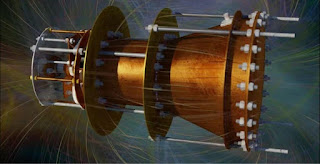The vast expanse of the cosmos presents a significant challenge to humanity's inherent curiosity to explore and understand. Despite our advancements, reaching our closest stellar neighbor, even at the highest feasible speed, would require years of travel. Yet, our relentless drive for problem-solving gives us hope, as exemplified by the innovative work of NASA engineer, David Burns.
In an effort to overcome the obstacles of interstellar travel, Burns has conceptualized an engine that could theoretically reach 99% of light's speed without resorting to propellant [2]. This intriguing concept, dubbed the "Helical Engine," leverages relativistic physics to achieve propulsion. It has ignited discussions reminiscent of the hype surrounding the early EM Drive era [3].
The idea behind the Helical Engine is complex yet captivating. Picture a box with a weight inside, connected to two springs. In the vacuum of space, the weight's movement would cause the box to oscillate, with the weight appearing stationary. If the weight's mass increased in one direction, it would exert a stronger push, generating thrust [4].
This contradicts the principle of conservation of momentum, but special relativity provides an interesting loophole. As objects near light speed, they gain mass. By replacing the weight with ions and the box with a loop, ions could theoretically move faster at one end, slower at the other, creating a net thrust [5].
Burns' Helical Engine, however, is not a simple closed loop but a helical structure resembling a stretched spring. The ions, confined within a loop, are accelerated to relativistic speeds. Their velocity, and hence their mass, is then varied to generate thrust.
The engine, devoid of moving parts except the ions trapped within electric and magnetic fields, sounds promising in theory. But practical implementation comes with significant challenges. According to New Scientist, the helical chamber would need to be sizable and the energy required to generate a minimal thrust is enormous.
Despite these hurdles, Burns remains optimistic. In the vacuum of space, the engine might just work, theoretically reaching 99% light speed given ample time and power.
The dream of interstellar travel continues to captivate us. As we strive for the impossible, it is innovations like the Helical Engine that keep the dream alive. Burns acknowledges the need for expert review and possible mathematical corrections in his work, but the bold concept opens new horizons for space exploration.


Post a Comment